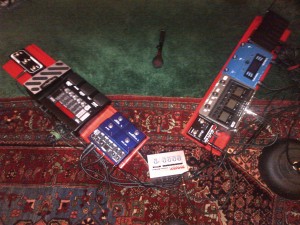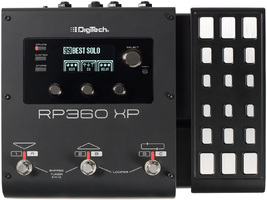
The 21st Century Harmonica Band: One Harp, One Looper, and My Patch Set
SPAH has announced that part of its program for SPAH 2014 will be the Harmonica Band reboot, in which attendees will have the opportunity to perform with a harmonica band featuring bass, chord, and diatonic or chromatic lead harps. I don’t have much desire to perform with a harmonica trio–its artistic appeal aside, it’s a format that excites little public interest in 2014, and I don’t see why that’s going to change–but the announcement made me think about some of the loops I’ve done lately in which the harmonica fills all the roles of a modern rock band except drums.
When you’re armed with a Digitech RP and one of my patch sets, you’ve got all the essentials for a basic rock or blues band. You’ve got bass sounds, sax sounds, organ sounds, chunky sounds for guitar-type chording, traditional amped harp sounds, and modern, exaggerated synth-y sounds. You can lay down multiple layers in a loop that fill out the sound spectrum from top to bottom. In other words, you’ve got a band.

The loops that follow all illustrate this principle in practice. They were recorded with a Digitech RP360XP into a Digitech JamMan Stereo looper. Both of them feature a bass line played on a harp that’s pitch-shifted down two octaves; one or more low-midrange harps, courtesy of the same pitch shifter set to an octave down; and a lead line played with an amped tone. There’s a “slide guitar” sound on the second piece, too. I did some crude beatboxing on the first piece.

These are rough performances, not polished pieces, and they’re intended to make a simple point: the range of sounds available in a Digitech RP with my patch set loaded is plenty enough to support a harp player who wants to create a full band sound. There’s no post-recording processing except for fades in and out. If you’ve got my patch set loaded on your RP, get a looper going and give it a try.
“Big Horns” This piece features one harp layer with my MA4D patch, which adds a perfect 4th down to the original tone, and another layer with an octave-down patch; the combination makes a power chord of root-5th-root. The harps jump out like a horn section.
Audio Player
“Quartet” The groove is a slow blues shuffle; the harp tones are dark blue. There’s a double-octave down patch for the bass, an octave down for low chords, a “slide guitar” sound and an amped blues patch for the lead.
Audio Player
Related Posts
Leave a Reply
You must be logged in to post a comment.
WHAT’S NEW
Categories
- Audio/Video
- Blog
- Blue Future
- Digitech RP Tricks and Tips
- Discography, CDs, Projects, Info, Notes
- Featured Video
- For the Beginner
- Gallery
- Hunter's Effects
- Hunter's Music
- Huntersounds for Fender Mustang
- Meet the Pros
- More Video
- MPH: Maw/Preston/Hunter
- My Three Big Contributions
- Player's Resources
- Pro Tips & Techniques
- Recommended Artists & Recordings
- Recommended Gear
- Recorded Performances
- Reviews, Interviews, Testimonials
- The Lucky One
- Uncategorized
- Upcoming Performances
- Zoom G3 Tips and Tricks